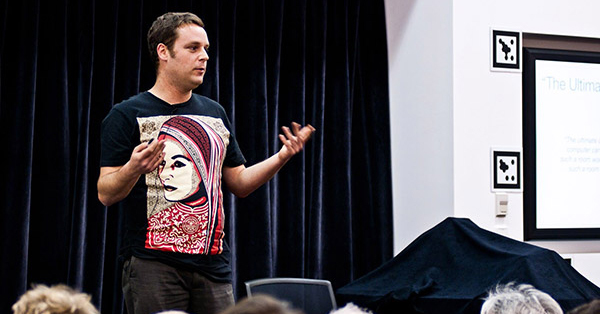 Christian Sandor, the chair for the Symposium on Mobile Graphics and Interactive Applications, recently chatted with Events for Gamers about SIGGRAPH Asia 2015 and more.
Christian Sandor, the chair for the Symposium on Mobile Graphics and Interactive Applications, recently chatted with Events for Gamers about SIGGRAPH Asia 2015 and more.
Events for Gamers: Please share with us a quick history of your involvement as the chair for the Symposium on Mobile Graphics and Interactive Applications and as a speaker at SIGGRAPH Asia.
Christian Sandor: Since 2000, I have a clear research focus on augmented reality (AR). As a result, with regards to conferences, I have volunteered many times at the IEEE International Symposium on Augmented Reality (ISMAR); most recently, I was the program chair in 2014 and 2015.
As SIGGRAPH has recently been expanding its scope toward augmented and virtual reality (VR), I have also started volunteering at SIGGRAPH Asia as a program committee member for technical briefs (2012), program committee member for emerging technologies (2013, 2014), and most recently program chair for Symposium on Mobile Graphics and Interactive Applications (2015).
I am excited to see that my research passion for the past 15 years is recently receiving a lot of attention!
E4G: The concept of AR, or augmented reality, has been around for a while now, and products like the Samsung Gear VR are becoming increasingly accessible to the average consumer. However, mainstream adoption of AR technology is still limited. What do you think are the challenges faced by mobile game developers in harnessing AR technology, and how can they best overcome said challenges?
 Christian: In my view, there are two main challenges for developing compelling AR games: First, we need solid AR platforms to run games on; second, we need to find game concepts that are suitable for AR.
Christian: In my view, there are two main challenges for developing compelling AR games: First, we need solid AR platforms to run games on; second, we need to find game concepts that are suitable for AR.
With regards to platforms I think that VR is always several years ahead of AR. For AR, we do not only have to create highly responsive computer graphics, but we have to additionally fuse them coherently with the user’s real environment. Any AR system can be trivially turned into a VR system; we just need to block the user’s view of the real world. However, for AR, there are several additional difficult requirements including matching the lighting conditions of the user’s environment and dealing with correct occlusions between real and virtual objects. Although especially Microsoft’s Hololens shows promising technological developments as an AR display, the quality is still several years behind the comparatively easier challenge that VR devices like the Oculus Rift or Samsung Gear VR are facing.
With regards to game concepts: At the moment, due to technical challenges, only research labs can run wide-area AR games. Therefore, this kind of scenario has only been insufficiently explored by game developers. Once the technology gets ready, I am looking very forward to what creative game designers can come up with!
E4G: In a TEDx talk a few years ago, you talked about the importance of considering a person’s perception of the world in which they are immersed, not just the matter of that world itself. How does AR get to the heart of this concept?

A recent example from our research is a prototype of an AR display, which measures the user’s eyes’ accommodative state. Simply speaking, from the accommodative state, we can derive the distance at which a user is focusing. Based on this information, we can apply a matching depth-of-field effect to the computer graphics that we embed into the user’s real environment. This is imperative for making real and virtual indistinguishable.
E4G: Is there anything beyond AR that you can see the mobile game industry moving into in the near future? How will this impact developers and designers?
Christian: Since 2005, I have been working on the integration of haptics into AR systems; haptics enables users to also touch virtual objects. In 2010, I presented a TEDx talk on this topic. (Watch the live demo; watch the full talk; check out the slides.)
In the aforementioned talk by Michael Abrash, he has also pointed out haptics as a key area for future research at Oculus Inc. So, I predict that haptics will be a key direction for the future of AR and VR.
While game designers are already familiar with the integrated experience of sound and graphics, it will be very interesting to see how haptics will be used by them!
E4G: Earlier this year, Konami CEO Hideki Hayakawa announced in a statement that “mobile is where the future of gaming lies.” What are your predictions on the balance between mobile and multiplatform console gaming for the next five years?
Christian: The questions are: Will AR and VR games succeed? If so, mobile or at home?
I see the most likely scenario as VR games at home and AR games for mobile.
E4G: What looks set to be the “next big thing” in mobile game design?
Christian: AR games.
E4G: Any advice for both veteran and rookie game developers on finding new ways to engage the player on mobile devices?
Christian: As we don’t yet know exactly how to exploit the AR/VR capabilities, rapid prototyping is essential. I often get asked how to get started with rapid prototyping AR experiences. My recommendation is to use Qualcom’s Vuforia + Unity3D. Vuforia runs on iOS and Android and provides all AR functionality. Then, prototyped scenes from Unity3D can be played in AR. E.g., see Vuforia SmartTerrain.
E4G: Anything else you would like to share about the success of SIGGRAPH Asia and any other special mentions for the 2016 event?
Christian: Besides the chairing the Symposium on Mobile Graphics and Interactive Applications, I am co-organizing the panel “Pioneers?? You can become one too!” together with Conference Chair Yoshifumi Kitamura. We have three very exciting panelists: Steven Feiner, Takeo Kanade and Tomoyuki Nishita.
Their advice will range from the expected (how to identify life-changing career opportunities and how to select great research questions) up to the unexpected (how to deal with the intricacies of academia, including organizational politics and malicious competitors).
It is scheduled before the Technical Papers Fast Forward on the first day.
E4G: Thanks for chatting with us about SIGGRAPH Asia!
Christian: See you in Kobe!
SIGGRAPH Asia 2015 is November 2-5, 2015, in Kobe, Japan.



